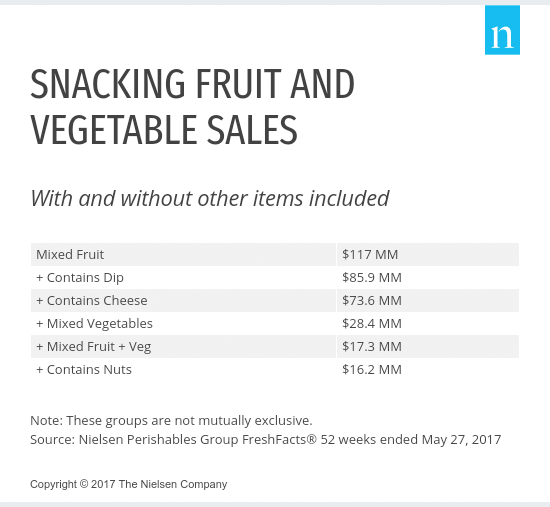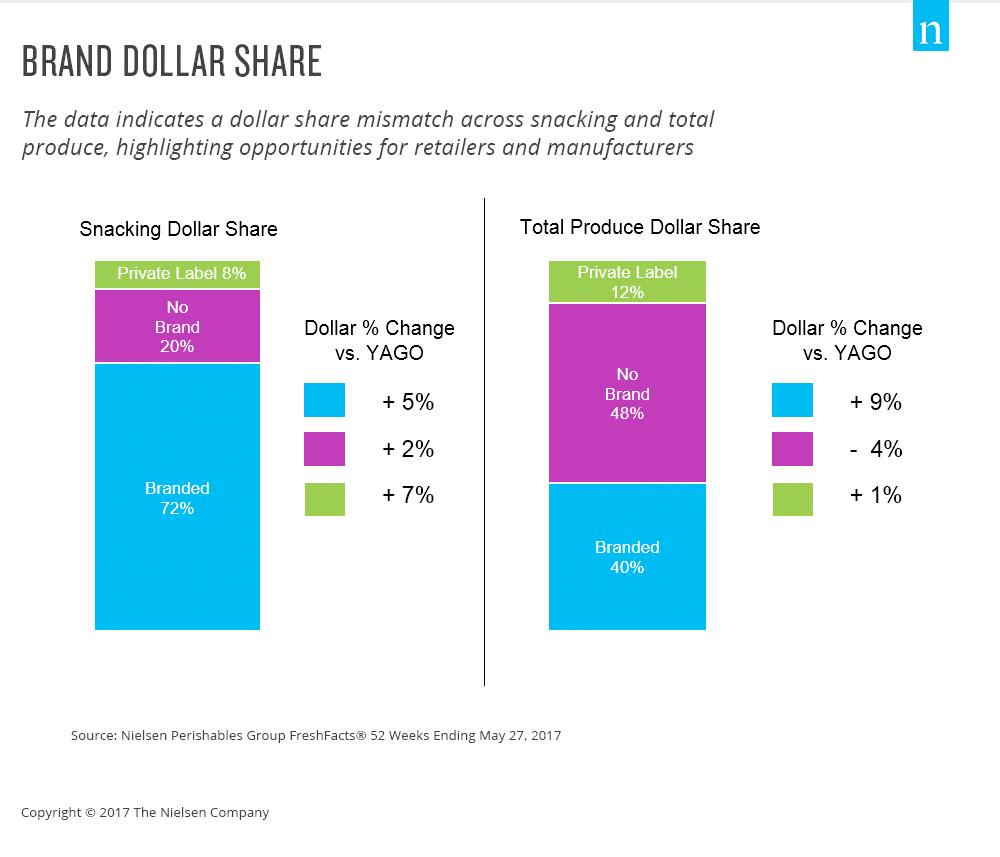On-The-Go Produce Snacking: A Billion Dollar Industry and Growing
August 23, 2017
![]() There’s no right or wrong way to snack, but there’s little doubt that Americans are growing increasingly health conscious as they reach for a bite in between meals—or in place of one. And as consumers’ hunger for healthful options rises, it’s important for retailers and manufacturers to stay on top of consumption trends in the produce aisle.
There’s no right or wrong way to snack, but there’s little doubt that Americans are growing increasingly health conscious as they reach for a bite in between meals—or in place of one. And as consumers’ hunger for healthful options rises, it’s important for retailers and manufacturers to stay on top of consumption trends in the produce aisle.
While not as big as the salty snack category, the “snackable” fruit and vegetable category is massive, with sales of $16.3 billion in the year ended May 27, 2017. While these products can easily serve as snacks, it’s impossible to say that every banana sale, for example, was consumed for that reason. So we set out to define a set of packaged items sold in the produce department for the purpose of snacking. This “on-the-go” snacking sub-category is a $1.1 billion area, and while many areas of the store have struggled to find growth, it posted a compound annual growth rate of more than 10% every year between 2012 and 2016. And to keep up with growing sales, manufacturers and retailers are doing their part to pacify increasing sales: 900 new snacking items have been added to grocery shelves over that period, 600 of which were individual-servings of fresh cut fruit—with and without additional items.
And in looking at consumer trends, manufacturers and retailers are seeing the benefits of combining fruit options with other items, such as vegetables, nuts and dip. For example, retailers sold $117 million in mixed fruit for the year ended May 27, 2017, but those sales were closely rivalled by sales of mixed fruit items that were paired with at least one other component.

On a national level, 32% of U.S. homes buy on-the-go produce snacks an average of 3.1 times per year. While families are clear stand-out buyers, younger generations and multicultural households also buy more on-the-go produce snacks than the average U.S. household.
In terms of share of on-the-go produce snacking dollars, fresh fruit is the stand-out winner, as 44% of on-the-go produce snacking is attributed to fruit options. Sales of on-the-go fruit snacks are also up 17% from last May. Comparatively, 17% of on-the-go snacking dollars come from fresh vegetables. This disparity is in large part attributed to four times more snacking fruit items on the shelves than their vegetable counterparts.

So amid the bevy of plantains, pineapple chunks and zucchini chips, where should retailers and manufacturers focus their efforts to stay ahead in the race to make the perfect fruit and vegetable salad? For starters, having options and variety is key. Healthful snacking transcends all retail outlets and can serve as a key point of differentiation within the produce department. Second, they should stay tuned in to potential mismatches between snacking and produce consumption trends

In looking at the data, retailers can see that private-label and unbranded options are somewhat under-represented in the on-the-go snacking space. This represents a possible opportunity to produce options in house to build market share and sales. The data also highlights that brands are growing at a faster rate in the department as a whole compared with on-the go snacking, which suggests room for improvement in branded snacking sales.
As with every category across the FMCG landscape, consumers have myriad options to choose from when it comes to snacking. Fresh produce items play a critical role in delivering on this need, but many fruits and vegetables still are not offered as an “on-the-go” snack—a $1.1 billion market that continues to grow. Understanding who, how, where and why shoppers choose different items for snacking can help uncover new opportunities for distribution, innovation and marketing to ensure success on an already crowded shelf.
Notes
“Snackable” produce includes grapes, cherries, apples, berries, bananas, stone fruits, oranges, mandarins and baby carrots.
The “on-the-go” snacking subcategory includes items that are intended for individual consumption in a single sitting, such as individual-sized cut fruit or vegetables, dried fruit and nut snack packs, fresh smoothies (16 oz. and below) and fruit cups.































